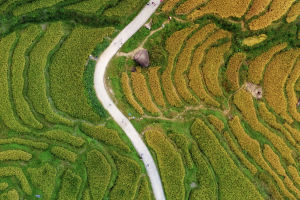The majestic Himalayan glaciers, the "Water Towers of Asia," are facing an unprecedented threat as they rapidly melt away. These towering ice formations, spanning several countries, hold immense significance for regional water resources, climate stability, and the livelihoods of millions.
However, the accelerating pace of glacier melt in the Himalayas raises alarming concerns about water security, ecological balance, and the future of vulnerable communities.
The Himalayas, home to some of the world's highest peaks, harbor a vast network of glaciers. These frozen reservoirs store immense amounts of freshwater, slowly releasing it over time, providing a lifeline to millions living downstream.
The rivers originating from these glaciers, such as the Ganges, Indus, Brahmaputra, and the Yangtze, nourish fertile plains and support agriculture, hydroelectric power generation, and drinking water supplies for millions of people in South Asia.
Scientists and researchers have observed a disturbing trend in recent years – Himalayan glaciers are melting at an accelerated rate. The consequences of this unprecedented loss of ice are far-reaching.
One of the immediate concerns is the increased risk of glacial lake outburst floods (GLOFs), where the sudden release of water from glacial lakes can lead to devastating floods downstream. These catastrophic events not only result in loss of life and infrastructure damage but also disrupt ecosystems and threaten biodiversity.
The rapid melting of Himalayan glaciers also poses long-term risks to water security. As glaciers shrink, the volume of water feeding the rivers diminishes, leading to potential water scarcity and conflicts over resources. The loss of this natural storage system exacerbates the vulnerability of communities dependent on glacier-fed rivers, especially during dry seasons when water availability is critical for agriculture, sanitation, and daily needs.
Furthermore, the retreat of glaciers in the Himalayas has broader implications for global climate stability. Glaciers act as natural reflectors, bouncing solar radiation back into space and helping to regulate temperatures.
As glaciers melt, darker surfaces are exposed, such as rock and soil, which absorb more heat, contributing to further warming. This phenomenon, known as the albedo effect, can create a feedback loop, accelerating the pace of global warming and exacerbating climate change impacts.
Multiple factors contribute to the accelerated melting of Himalayan glaciers. Rising temperatures linked to climate change play a significant role. The Himalayan region is experiencing warming at a faster rate compared to the global average, intensifying the ice loss. Additionally, pollution and black carbon particles settle on the glacier surfaces, reducing their ability to reflect sunlight and enhancing melting.
Addressing the challenges posed by the melting Himalayan glaciers requires urgent action on multiple fronts. Mitigating climate change through global efforts to reduce greenhouse gas emissions is paramount. Adopting sustainable practices, investing in renewable energy sources, and promoting reforestation can help curb the pace of global warming and preserve the fragile Himalayan ecosystem.
Furthermore, implementing adaptation strategies is crucial to mitigate the impact on vulnerable communities. Enhancing water resource management, developing efficient irrigation systems, and promoting water conservation practices are essential steps toward ensuring water security in the face of diminishing glacier reserves.
International cooperation is also critical in addressing the transboundary nature of the Himalayan glaciers. Collaboration between nations sharing these valuable water resources is necessary to develop comprehensive strategies, share data and research, and establish early warning systems to prevent and mitigate the risks associated with glacial melt.
The accelerated melting of the Himalayan glaciers poses severe consequences for water security, climate stability, and the livelihoods of millions. Urgent action is required to address the underlying causes of glacier retreat and mitigate its impacts. Preserving the Himalayan glaciers is not only crucial for the regions directly affected but also for global climate resilience.


